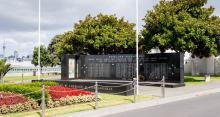Flying from HMS Illustrious, on raid to an oil refinery at Palembang, Sumatra, his Corsair was shot down by Anti-Aircraft fire. After bailing out he was captured as a POW. He was taken to Singapore and along with 7 other Fleet Air Arm aircrew, was executed on the beach at Changi, on or about 31st July 1945. [For Your Tomorrow, Errol Martyn, Vol 2, pp 317,353]
"Sub-lieutenant (A) J. K. Haberfield, RNZNVR, of HMS Indomitable, and Sub-Lieutenant (A) E. J. Baxter, RNZNVR, of HMS Illustrious, were shot down on 26 January 1945 during an attack on the oil refineries at Palembang, Sumatra. They were captured by the Japanese and, in February 1945, sent to Singapore where they were placed in Outram Road gaol. At the end of July 1945 they were executed, together with seven other Fleet Air Arm pilots.
Earlier reports said that the prisoners were missing after the transport in which they were being taken to Japan from Singapore had been sunk by Allied air bombing in the middle of March 1945.
Koh, a Chinese prisoner in Sumatra, said that after his release on 20 February 1945 it was town gossip that the photograph of a well-built, blind-folded pilot prisoner was shown for propaganda purposes at the premises of the Palembang Sumboeng, a local newspaper. From the description it tallied with that of Haberfield. Koh said that Haberfield was admitted to the Palembang Prison on or about 1 February 1945. When he was being interrogated, his requests for food and water were refused. On the seventh day of his confinement Haberfield was taken, blindfolded, to an unknown destination.
Lieutenant Commander L. F. G. Pritchard, RNVR, who was responsible for the investigation of this atrocity, said that in September 1945 it was known that thirty-two pilots had been lost. A report was received that certain British prisoners had been executed and they were thought to be Fleet Air Arm pilots. Investigations were continued for a month and it was found that they were not Fleet Air Arm pilots. The inquiry then had to start afresh.
This time it was begun at Palembang, where it was learned that nine Fleet Air Arm pilots had been sent thence to Singapore. After many people in Singapore had been interrogated, Captain Toshio Kataoka was found; he said that the men had been shipped to Japan, but on their way the ship was sunk and all were presumed to have been drowned.
‘We thought that was the truth, because as a rule in a big centre the Japanese did not execute prisoners of war without a court martial. After a few weeks General Atsuka, who was Chief of the Judicial Department of the 7th Area Army, Singapore, let the cat out of the bag. He did so because he thought we knew that these men had been executed without trial and he did not want his department to be blamed. He gave the rumours he had heard before the Japanese surrender. Within 24 hours we had the whole story, or a good part of it and sent out orders for the arrest of the culprits. They were warned at 6 p.m. that they would be going to Singapore next day and were not prepared to face the music and committed suicide on 26 December 1945. There were others who were believed to be implicated in the affair and it is possible that they may be brought to trial as accomplices.’
There was no trial before the execution of the prisoners. The two Japanese particularly concerned were Captain Toshio Kataoka, who was the senior officer, and a Captain Ikeda. These men committed suicide.
Kataoka, in a will made before his suicide, said:
We took nine prisoners from Outram Road in a lorry to the beach at the northernmost end of Changi and executed them with Japanese swords. The bodies were put in a boat prepared beforehand and sunk in the sea with weights attached. Now that the responsibility must be borne out publicly, I hereby pay for my deeds with suicide." {Waters (1956), Appendix V]


